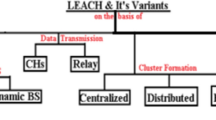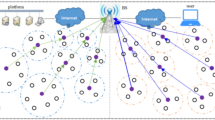Abstract
This paper proposes a scheme for constructing a mobile ad hoc network (MANET) based on clusters. The proposed MANET architecture is made up of two hierarchies. One hierarchy is the backbone network which is made up of cluster heads and associate nodes, and the other hierarchy is the cluster which is made up of one cluster head and multiple cluster members. In the proposed cluster generation algorithm, the number of potential cluster members is used as a metric, and it is always the new node with the maximum number of potential cluster members that is elected as a cluster head. In this way, the number of cluster heads is minimized. In this scheme, only one associate node is used to achieve the communication between two cluster heads, so the number of nodes included in the backbone network is minimized. This scheme also proposes the cluster merging algorithm in order to maintain the minimum number of cluster heads. In the proposed cluster repair algorithm, if a cluster head fails/moves out of the cluster, then a new cluster head is elected to maintain the cluster stability. From the perspective of the cluster stability, this paper analyzes the performance parameters of the proposed scheme, and the data results show that the proposed scheme improves the MANET stability.

















Similar content being viewed by others
References
Wang, X., & Qian, H. (2012). Constructing 6LoWPAN wireless sensor networks based on cluster tree. IEEE Transactions on Vehicular Technology., 61(3), 1398–1405.
Elhdhili, M. E., Ben Azzouz, L., & Kamoun, F. (2008). CASAN: Clustering algorithm for security in ad hoc networks. Computer Communications, 31, 2972–2980.
Luo, J. & Hubaux, J. P. (2004). A survey of inter-vehicle communications. Technical report IC/2004/04, EPFL.
Hong, X., Xu, K., & Gerla, M. (2002). Scalable routing protocols for mobile ad hoc networks. IEEE Network, 16(4), 11–21.
Iwata, A., Chiang, C. C., Pei, G., Gerla, M., & Chen, T. W. (1999). Scalable routing strategies for ad hoc wireless networks. IEEE Journal on Selected Areas in Communications, 17(8), 1369–1379.
Li, L.-S., Lee, G.-C., & Wang, W.-Z. (2009). A root-based strategy for constructing a clustered MANET in all-IP networks. Computer Standards & Interfaces, 31, 699–706.
Lee, K.-W., Seo, W.-K., Cho, Y.-Z., et al. (2010). Inter-domain handover scheme using an intermediate mobile access gateway for seamless service in vehicular networks. International Journal of Communication Systems, 23, 1127–1144.
Wang, X., & Qian, H. (2012). Hierarchical and low-power IPv6 address configuration for wireless sensor networks. International Journal of Communication Systems. doi:0.1002/dac.1318.
Alzoubi, K., Li, X. Y., Wang, Y., Wan, P. J., & Frieder, O. (2003). Geometric spanners for wireless ad hoc networks. IEEE Transactions on Parallel and Distributed Systems, 14(4), 408–421.
Chen, Y. S. & Lin. T. H. (2005) A QoS routing protocol using cluster-mesh-tree for IEEE 802.15.4 low-rate WPANs. WASN 2005.
Chatterjee, M., Das, S. K., & Turgut, D. (2002). WCA: A weighted clustering algorithm for mobile ad hoc networks. Journal of Cluster Computing, 5(2), 193–204.
Sakhaee, E., & Jamalipour, A. (2008). Stable clustering and communications in pseudolinear highly mobile ad hoc networks. IEEE Transactions on Vehicular Technology, 57, 3769–3777.
Su, H., & Zhang, X. (2007). Clustering-based multichannel MAC protocols for QoS provisionings over vehicular ad hoc networks. IEEE Transactions on Vehicular Technology, 56, 3309–3323.
Zhang, X., Su, H., & Chen, H. H. (2006). Cluster-based multichannel communications protocols in vehicle ad-hoc networks. IEEE Wireless Communications, 13, 44–51.
Song, M., & Cuckov, F. (2010). A mobility-aware general-purpose vehicular ad-hoc network clustering scheme. Journal of Information Science and Engineering, 26, 897–911.
Wang, X., & Qian, H. (2012). Constructing a VANET based on cluster chains. International Journal of Communication Systems. doi:10.1002/dac.2484.
Kim, I.-Y., Kim, Y.-S., & Kim, K.-C. (2006). Zone-based clustering for intrusion detection architecture in ad-hoc networks. In Proceedings of the Ninth Asia-Pacific network operations and management symposium (APNOMS 2006), Lecture notes in computer science (Vol. 4238). Berlin: Springer.
Samad, K., Ahmed, E., & Mahmood, W. (2005). Simplified clustering scheme for intrusion detection in mobile ad hoc networks. In Proceedings of the 13th international conference on software, telecommunications and computer networks (SoftCOM), September 2005.
Yu, C. W. Chang, C.-C., & Chou, J.-H. (2009). Minimizing the number of clusters in IEEE 802.15.4 wireless sensor networks. In The first international workshop on wireless and mobile networks (WiMoN-2009).
Gerla, M., & Tsai, J. (1995). Multicluster, mobile, multimedia radio network. ACM/Baltzer Journal of Wireless Networks, 1, 225–238.
Chen, G., Nocetti, F. G., Gonzalez, J. S., & Stojmenovic, I. (2002). Connectivity based K-hop clustering in wireless networks. In Proceedings of the 35th Hawaii international conference on system sciences.
Sheu, P.-R., & Wang, C.-W. (2003). Minimizing both the number of clusters and the variation of cluster sizes for mobile ad hoc networks. Lecture notes in computer science (Vol. 2662, pp. 682–691).
Chen, Y. P., & Liestman, A. L. (2002). Approximating minimum size weakly-connected dominating sets for clustering mobile ad hoc networks. In Proceedings of the 3rd ACM international symposium on mobile ad hoc networking and computing. ACM, pp. 165–172.
Lu, G., Sadagopan, N., Krishnamachari, B., & Goel, A. (2005). Delay efficient sleep scheduling in wireless sensor networks. In Annual joint conference of the IEEE computer and communications societies (Vol. 4, pp. 2470–2481).
Han, B., & Jia, W. (2007). Clustering wireless ad hoc networks with weakly connected dominating set. Journal of Parallel and Distributed Computing, 67, 727–737.
Wikipedia. (2013). The free encyclopedia–mobile ad-hoc network. http://en.wikipedia.org/wiki/Mobile_ad_hoc_network, March 2013.
Fall, K., & Varadhan, K. The ns manual. http://www.isi.edu/nsnam/ns/.
Camp, T., Boleng, J., & Davies, V. (2002). A survey of mobility models for ad hoc network research. Wireless Communications and Mobile Computing (WCMC), 2(5), 483–502.
Deng, J., Han, Y. S., Chen, P.-N., & Varshney, P. K. (2007). Optimal transmission range for wireless ad hoc networks based on energy efficiency. IEEE Transactions on Communications, 55(9), 1172–1182.
Wikipedia. The free encyclopedia—omnidirectional_antenna. http://en.wikipedia.org/wiki/Omnidirectional_antenna.
Kim, M.-S., Lee, S. K., & Golmie, N. (2012). Enhanced fast handover for proxy mobile IPv6 in vehicular networks. Wireless Network, 18, 401–411. doi:10.1007/s11276-011-0407-y.
Acknowledgments
This work is supported by National Natural Science Foundation of China (61202440).
Author information
Authors and Affiliations
Corresponding author
Rights and permissions
About this article
Cite this article
Wang, X., Cheng, H. & Huang, H. Constructing a MANET Based on Clusters. Wireless Pers Commun 75, 1489–1510 (2014). https://doi.org/10.1007/s11277-013-1434-z
Published:
Issue Date:
DOI: https://doi.org/10.1007/s11277-013-1434-z




